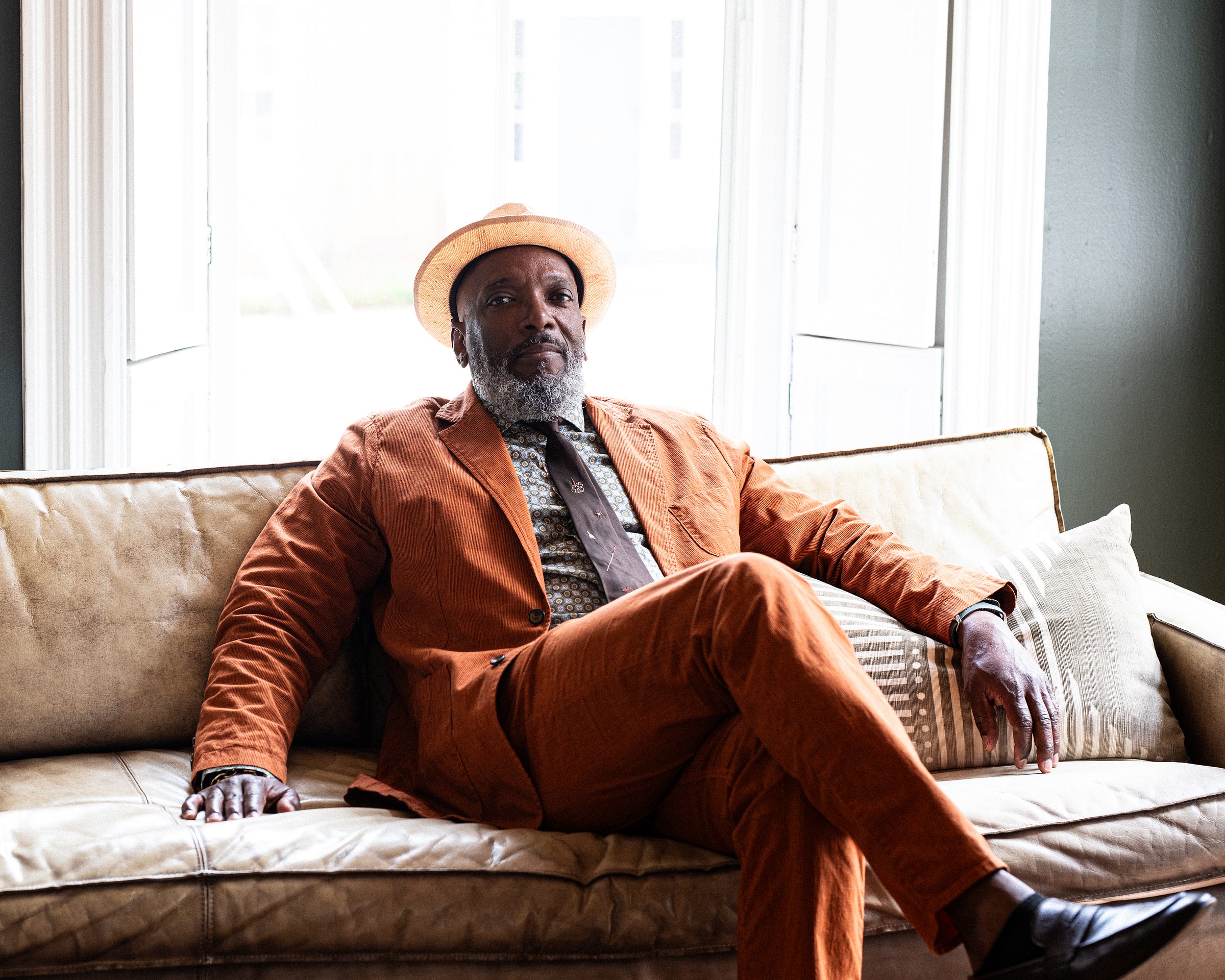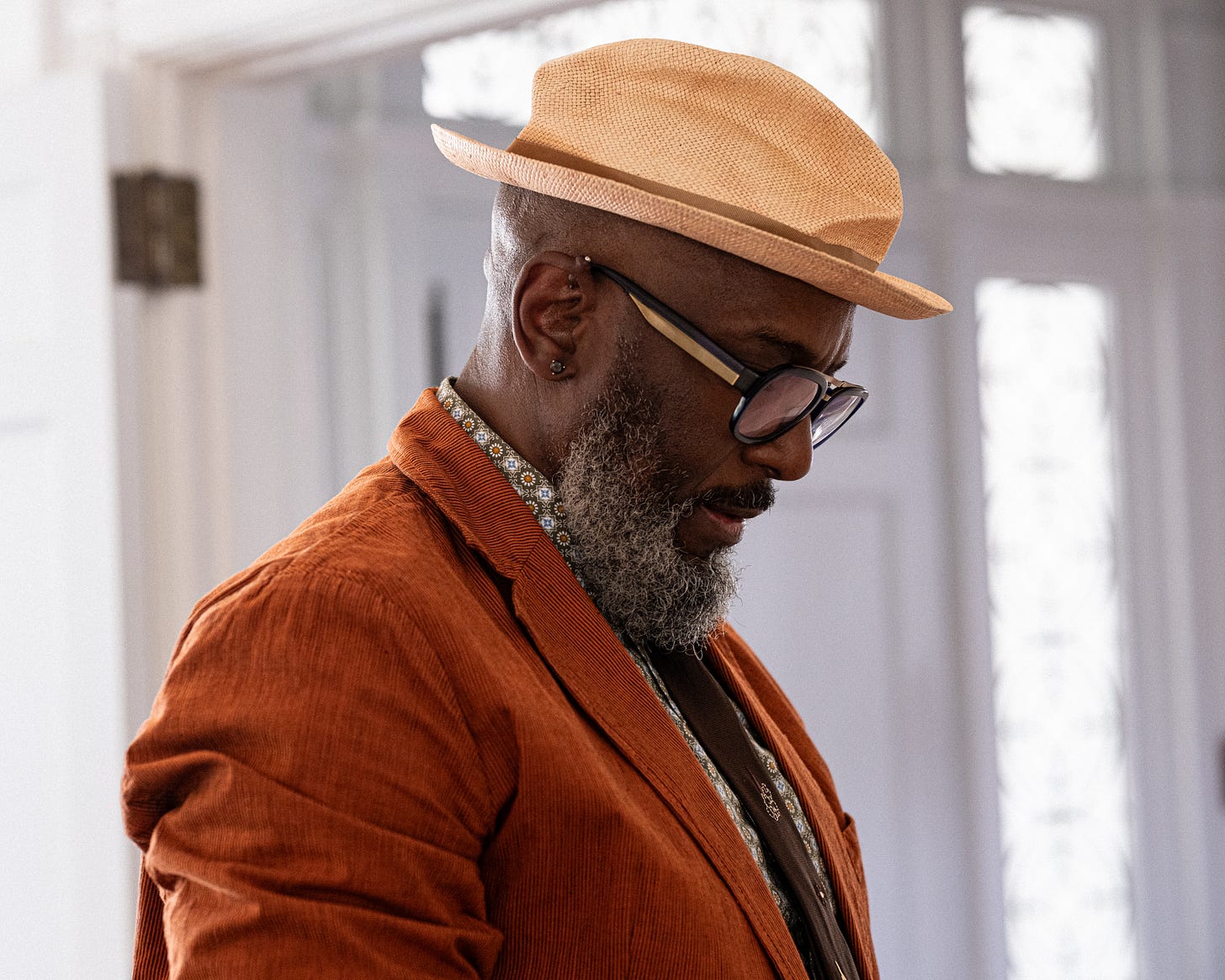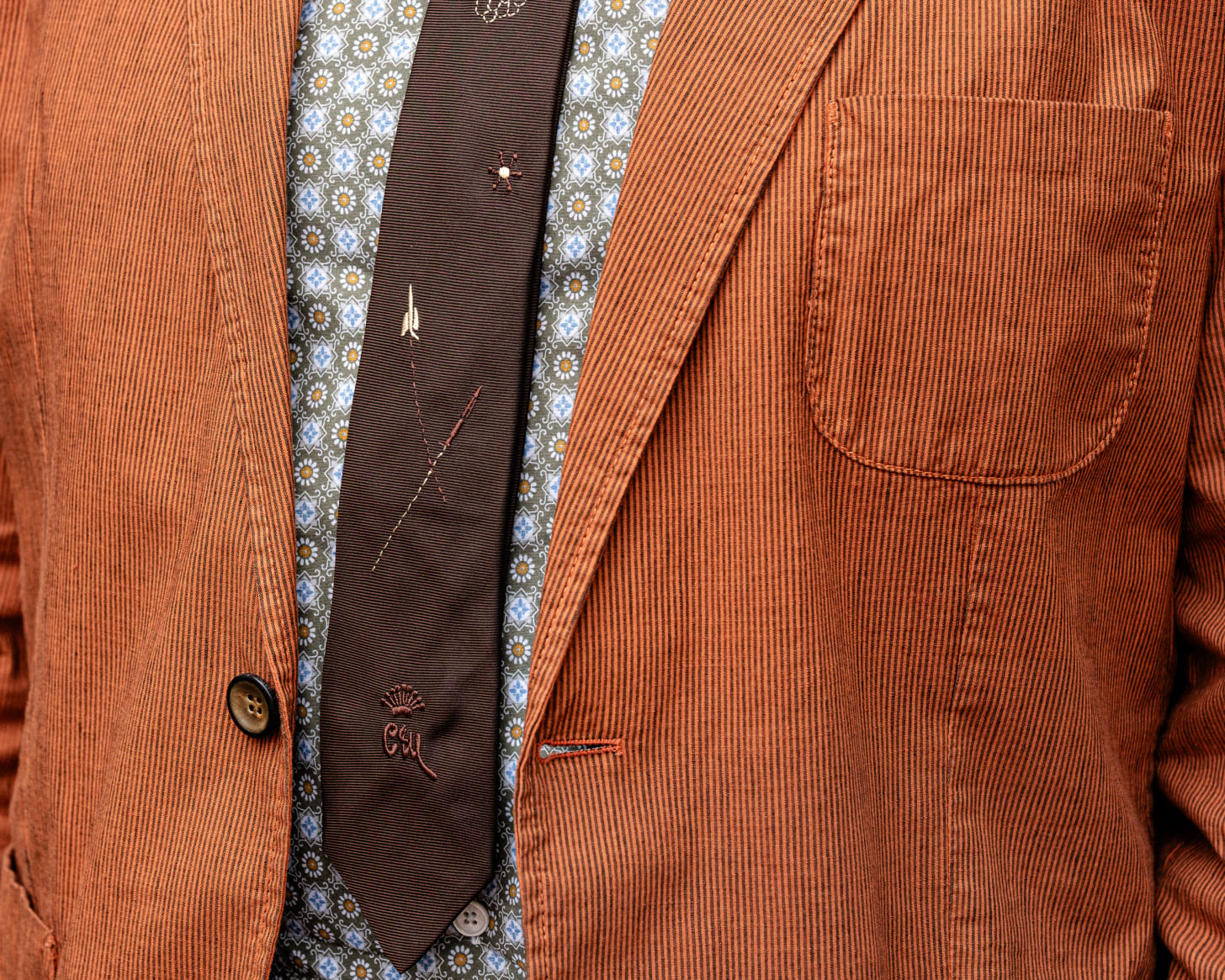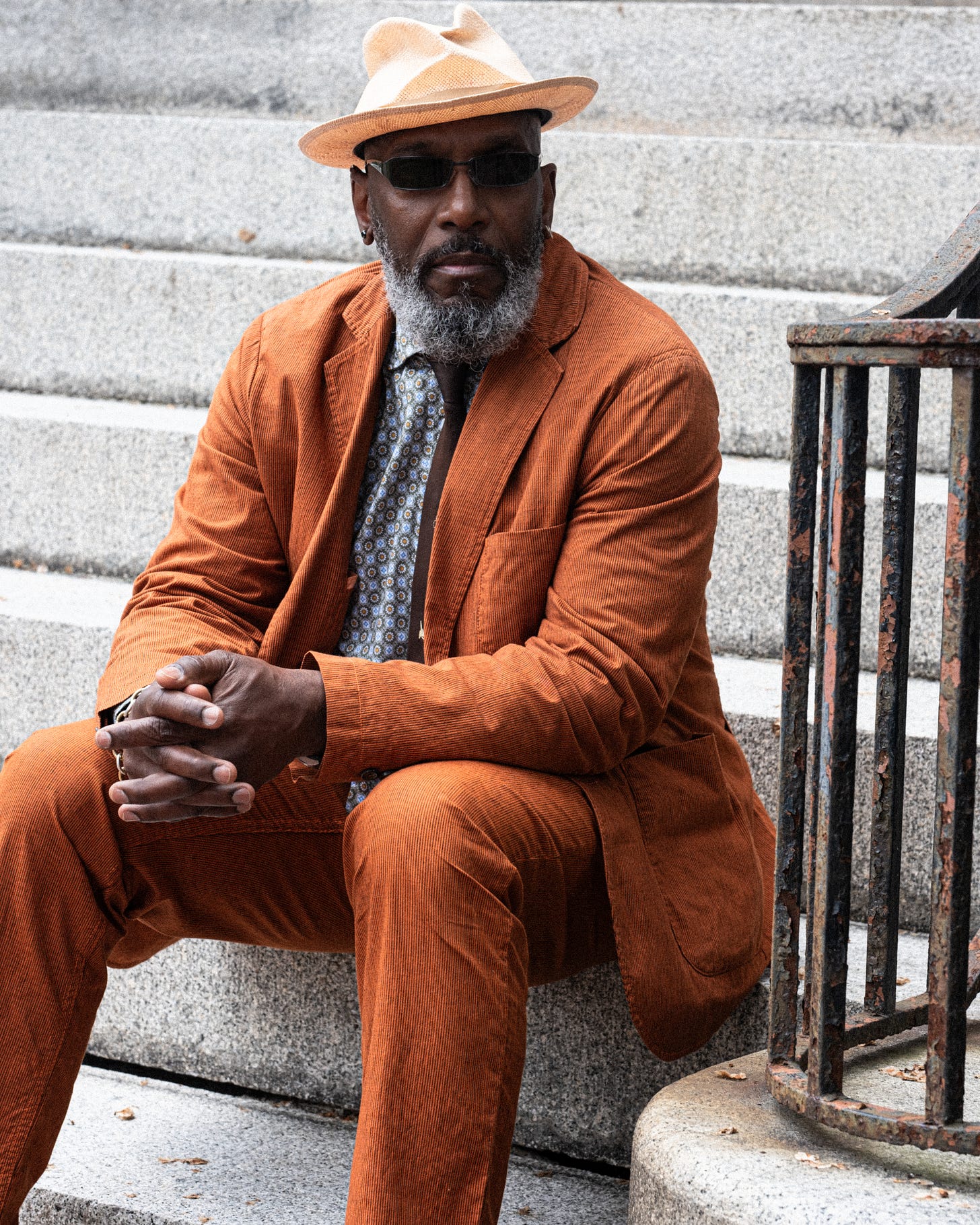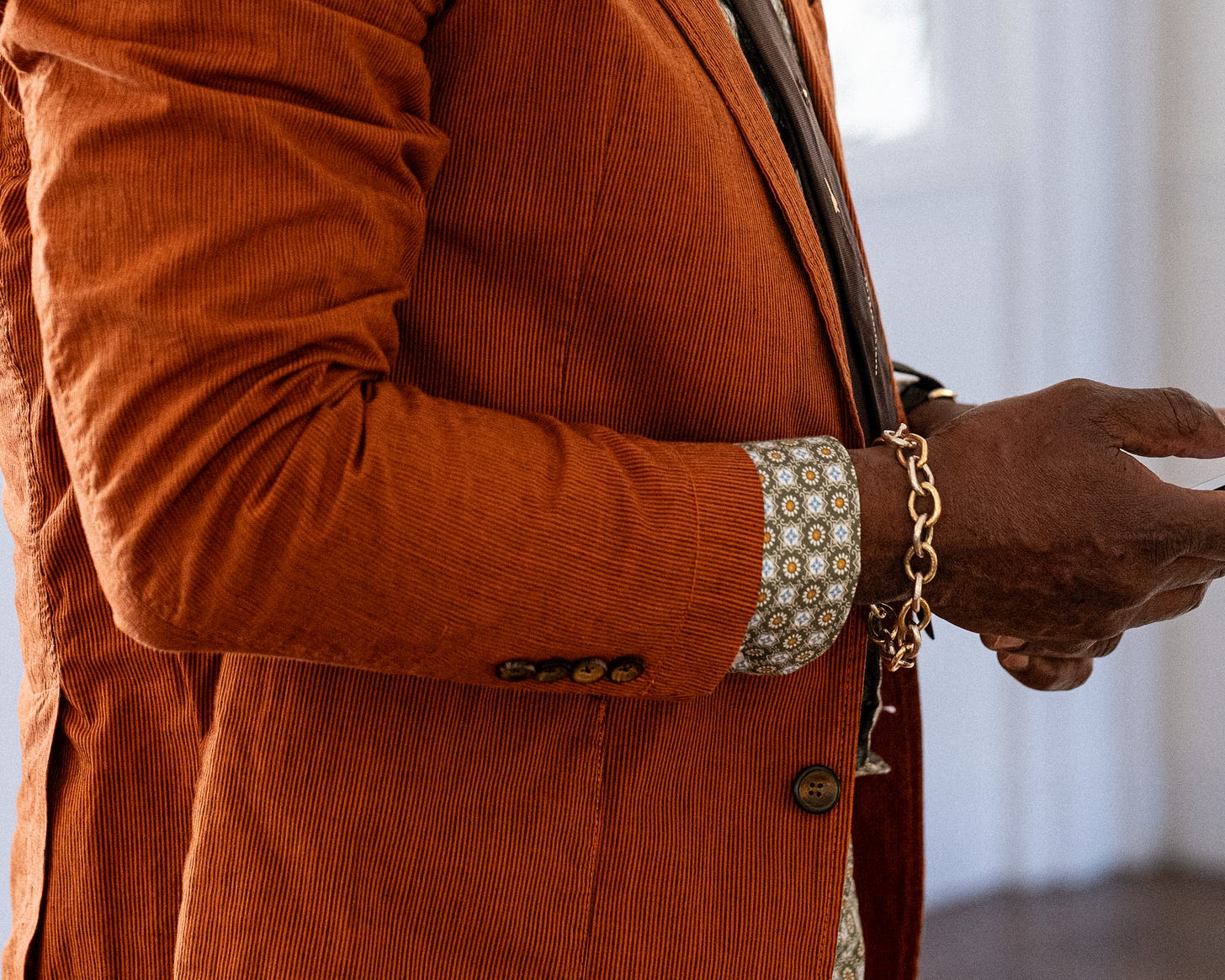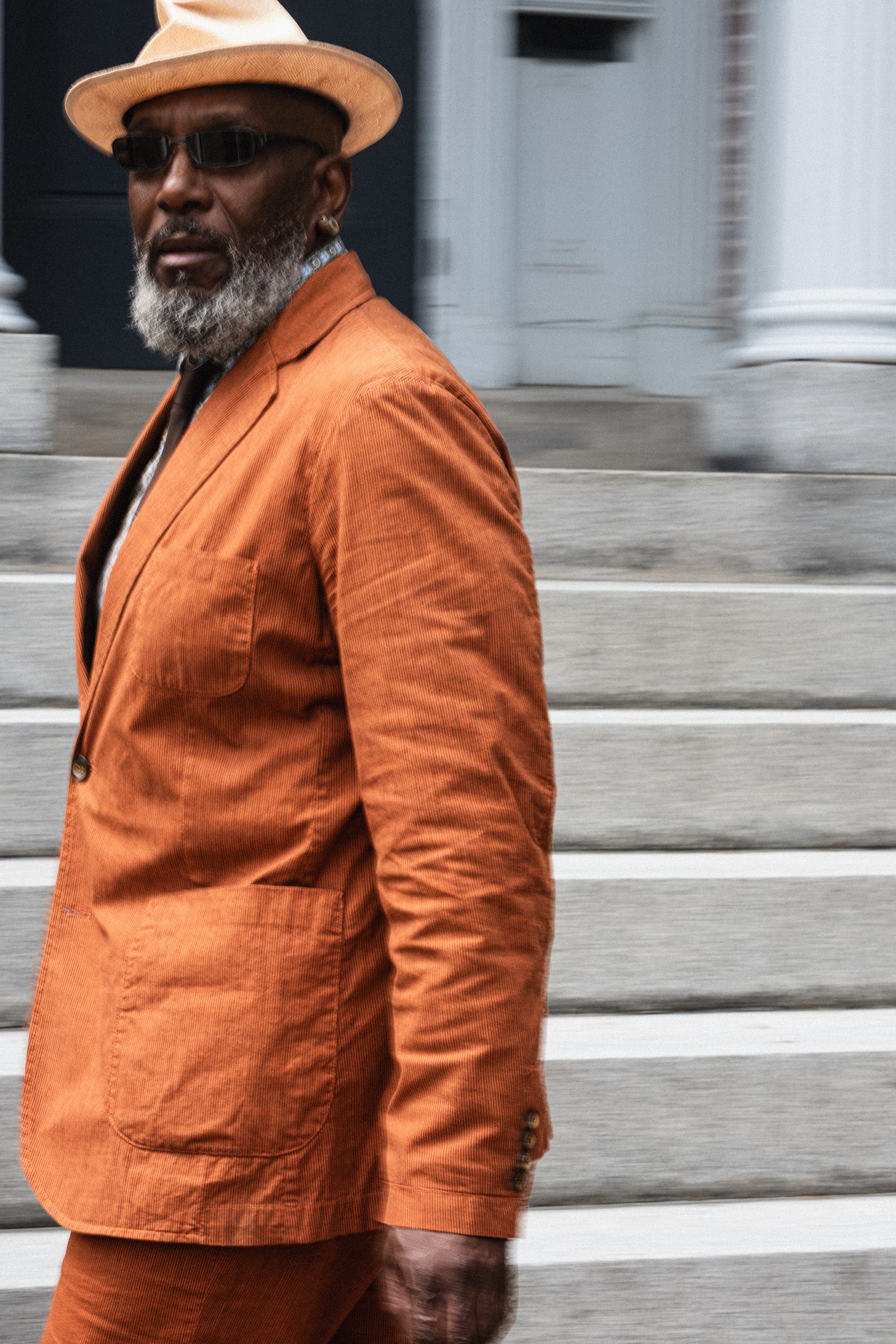Louis Pickens is the owner & chef of Black Betty Bistro. He talked with me about the lifelong approach of curating his more-is-more style. More positive vibrations, more flavors, and more closet space.
Interview and portraits by Georgia Dixon | Blind Tiger Portland, June 11, 2025
Can you talk about what you're wearing and what makes it your dress code?
This suit was made for me by David Wood about eight years ago. I bought the trousers and I was like, man, it'd be nice to have a jacket to match it. And so they put the jacket together. I've worn it once in eight years. Just goes to show you that I have too many clothes [laughs].
The hat is a paper straw that we got in Milan and it’s a crusher, so I can take it anywhere. The style is Dapper Hobo; it’s just insane what they do with hats. I'm very much a hat person, I can't tell you how many hats I own. I can't tell you how many pairs of shades I own. Same with kicks. Yeah. And I've been this way since forever.
Style has always been a thing for me. That's the first impression someone's gonna have of you. Unless, you engage them. But if you don't, that memory of you, that first encounter, that first visual of you is gonna stay with them.
Be conscious of the opportunity that you might have to engage someone. You want to leave them thinking, I'd do that again.
It’s kind of an effortless thing, you know, I like to feel good. And when you look good you project this good energy. And then you go about your business. It’s kind of like a warrior; you cloak up and then you're ready for combat.
On being seen as the style advisor at home.
I am the style advisor. They trust me so, yeah, I own that position. But I welcome that. Because when [my family] goes out, they represent me; when I go out, I'm representing them, you know?
And when I say “representing” it's the whole embodiment of it. It's what I do in the community, who I feed, who I work with. I'm owning that element of being a creative person, being a family man, being a community man, being someone who's consistently consistent, that looks good, being consistent.
I've been in stores in different places in the States and abroad where people are like, “What do you think of this?” — I think people who are not too confident in their style, I think they have to take a chance. You have to be about the uncertainty of it. And then that's how you develop it.
But it's not easy. I was always taught, if you do the easy thing, life is hard. If you do the hard thing, life is easy. So I embrace the hard thing, I do.
The thing about style is that it’s constant work. You've been curating, you've been thinking, you've been building your style over decades.
Over forever.
And some people are just born with it. And I think it's a cool thing. Art and fashion and food and design — it's all the same thing. It's all the creative element. They all go hand in hand. You can't tap into one without tapping into the other. If you wanna be a stylized person, you have to embody all of it. And then you'll see, you'll get it. That’s when it becomes easy.
I was always taught, if you do the easy thing, life is hard. If you do the hard thing, life is easy. So I embrace the hard thing, I do.
The first time I saw you was at a fundraiser for Portland Community Squash [Squash Ball]. Most everyone was dressed in the suit and tie look — and then you come in, looking totally different. You've got the hat, the letterman jacket, all of it. Do you have a methodology for how you get dressed?
I'm always aware of what I put on, on the daily. I never go out really unintentional. I don't.

For the squash ball, I had the letterman jacket, and I thought, well, it's a squash ball. There's an athletic element to it. And, it's a ball at the same time. So I found a tie, I found a shirt and slacks that matched the tie.
And this is all from the archives, you know. I can go in there for things like this vintage tie. This is from the 30s, Neiman Marcus. This is one of my grandfather's. 100% silk. I have about 80 of these. All different looks. All from my grandpops.
I have a Burberry coat from him from the 30s that is ridiculous. It’s a trench, with calf skin pockets. It's so badass. When I put it on, everybody stops and says something.
I love, I love, I love draping up. I love the winters. I used to didn't, but you know, I came here and I started to embrace the snow. You can look good in the winter.
I love fall into winter, you start being able to wear all the different outerwear.
What I've decided — in about the last six or seven years — is that you can wear anything, anytime.
The first style reference you made was David Wood. You brought him up when we first met, and now today you’re wearing a suit from the shop. What is it about David Wood that makes him your first style reference in Portland?
The thing about David Wood is, he's here in Portland, but he could do anything, anywhere in the world. He's such an individual, and he's probably the best put-together-person I’ve seen. People come to his store from all over the country and he’s connected with people all over.
In his travels abroad, or if he was at a fashion shows, he would see a piece and say, “I know that's for you.” He admired my style. I would come into the store, and he’d be like, “Louis, look in the mirror. Man, you just got it.” So he recognized style. I’d recognize his style, too. He might be my style icon.
On putting together a look.
It’s art. It’s improv. You can't have a formula when you're creating art.
My family's so rooted in the South with the chapeaus and the kicks. Me, I'm just freestyle. I draw references from everywhere.
I like to take some streetwear and incorporate it with the southern dapperness. And then you create a dapper/casual kind of vibe. Like if you've got the right kind of suit, then you can put some sneaks and then you put a chapeau and then you put the goggles — then you're creating a real individual look.
It's art. It's improv.
It is an art, I think. There's an eye to it. There's a feeling to it that you can't just come up with out of thin air. Sometimes it takes time.
It's true. Earlier when I was on my way to meet you, there were these two Black guys and one guy said, “man, I want to be like you.”
I said, “Do it!”
When I go out, it's about the vibration. I want to vibrate so high that I influence somebody to get up off their ass and go to the gym or go buy a jacket or go buy a hat. It's about healing. These are things that are healthy for your mental state.
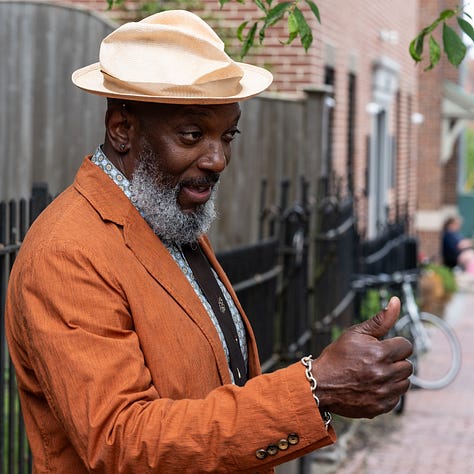
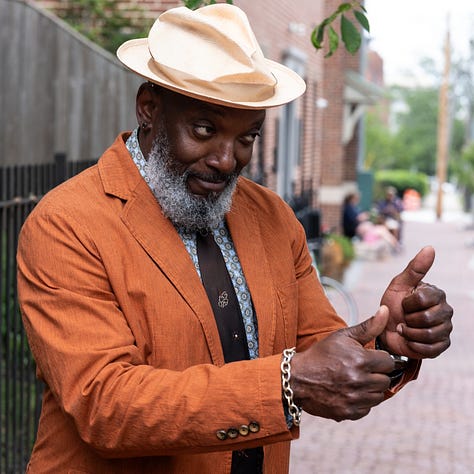
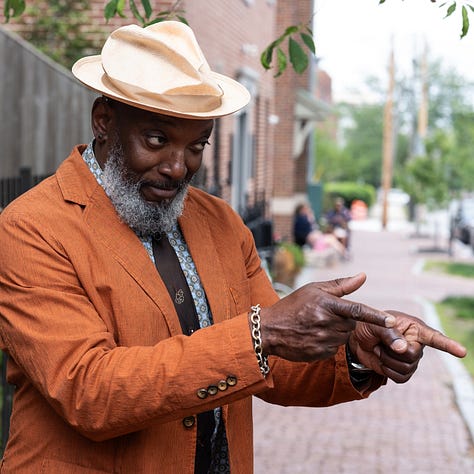
It's connection.
It’s hard that people don't grasp that element of [style]. It's all one thing, but you have to be open to it, or quiet the noise enough to be one with it. It's just like connecting with a piece of art. It's healing, and I wish more people would just take time to be about it. Life is so short, you know.
The David Wood shop talks about their methodology as ‘less is more’ — a lean wardrobe with lasting garments. I'm curious how this aligns with your approach because it’s sounding like, for you, more is more.
More is more. More is more. And sometimes more can even look like less.
To me, it's all art. I mean, yes, you want the fine garments, you want materials that will breath, and clothing that accentuates your body type. But I think it's improv. You can't have a formula when you're creating art. You know what I mean? It's open to interpretation. It's whatever you do, whatever you feel, whatever you present.
I like nice things. And if you have enough nice things, all that less is more is out the window.
Style is this ever evolving thing. We change, our style changes over time. So how do you feed that creative spirit?
One thing I do when I travel is I go online to see the street style from various countries to see what it's all about. It’s people creating their own style.
I also follow designers, like John Galliano. He’s an insane designer. He can do it all.
I tap into magazines. It could be art magazines or floral magazines — you'll always find interesting designers there. People who design wardrobes or chairs. I have a creative mindset and I'm always looking for something to pique my interest toward food, fashion, art.
On the art of creating good food.
When you eat my food, I want you to taste the love.
For the last three years I've been a Chef in Residence at Colby College. It’s through the Lunder Foundation, and they bring in artists from all over the world to have these suppers every summer. Most of the artists are Indigenous or Black or Latino, you know, very diverse.
There are over 3,000 pieces of art in the museum and we get to design meals around the art. So I go in, select a piece of art, and then design a meal around it. I get to know the artists and then talk about how they influenced me to create the food. Not just related to their art, but their views, how they moved in time and space and what they lent their energy to. How the art was relevant to the circumstances in the world, in the country.
This will be my third year, and the whole month of July is my month. So once a week in July, I'll get to put on a show.
You give a talk about the food & art connection?
Yeah, I get to talk about it. I get to know these artists, who they are, like really intimate details so that I can first create the food and then kind of create a connection with them so I can then reference the art with the food. There's been instances where the food even looked like the piece of art.
People have pointed that out to me, they’ll go, “oh, look at the onions and the beets, see how they referenced the colors in the work.”
I think sometimes when it happens, it's just the relationship I’ve established with the artists. Most of these artists are gone, but I think somehow through my research and me trying to be really detailed and represent them to the best of my ability, there's a connection.

At a dinner like that, is there something that makes the food uniquely yours?
My grandmother and grandfather were both chefs, so I really learned from them how to create flavors. I'm a flavor person, like everything and anything. I have a spice kit that I make, I call it 1100 Spices [eleven hundred spices].
People don't believe it's 1100 spices in it, but every time they eat my food, they go, “what is that?”
I say, “oh, that's my 1100 spices.”
They go, “oh, get out of here.” (laughs). But it's true.
I've researched spices from all over the world. And through painstaking methods, and over many years, I've created this spice. And so it's uniquely mine, but it's been influenced by all these great people I had the pleasure of working with.

When I make my food, I try to create opportunity and experiences. When you eat my food, I want you to taste the love. So that's how I approach it. Even when I’m making the food, I'm feeling it. I’m like, man, they're gonna lose their mind! I'm saying this to myself and I'm believing this. And I'm not stopping until it's there.
I think that's why I've had the success I've had. I don't do any massive advertising. For years now, I've been leasing churches, I lease restaurants — I go in the wee hours when no one's there, do my thing overnight, then serve it the next day.
Right now I'm trying to get funding to build out my own place. I’ll be doing a proposal with the Black Farmers Fund. They fund minority businesses to help them build out and get necessary machinery and things, whatever their dream may be.
So that's what I've been working on. It seems like forever. But you know, I'm not worried. I think when it happens, that will be the perfect time for it to happen.
All this work is just creating opportunities and having experiences with people. What I represent and what you see, that's what I represent in the food. It's what I represent in my community. It's what I represent for my family. And it's what I represent spiritually, you know. High quality, high level, 100% all day, every day.
You're so excited to feed someone something amazing every single time you cook.
Every time. And it's grueling and that's part of it. It needs to be a sense of suffering. It needs to have some blood to it. So that you can experience it. And that's where I am.
I think I'm weird, I do. I think I'm a one-off because I care, you know. I care. A lot of people who are successful in this business, they don't. They dread it. But just think if you had a little more passion about it, how fulfilling that might be.
That's how I choose to move, with style and grace.
With style and grace. And 1100 spices.
Yeah, 1100 spices! That's how you know it's me.
It's all part of your growth and you can't predict any of it and you shouldn't shield yourself from it, because it's all going to just take you to where you need to be in the end.
You grew up in Texas, in this home that had a big, old stove in the center of the kitchen. That's how your catering business, Black Betty, gets its name. It was all about family, conversation, love, laughter, everything.
What do you think it is, specifically about cooking and eating, that's so nurturing?
It’s the one thing that everybody can be about. You know, it bridges so many gaps. Food is such a bridge for indifference.
That's the intimacy in providing that. When I make food, I understand that I become one with whoever takes that food because I brought that to life. So therein lies the intimacy. That’s the gift that I get. And it's the gift that I give. I never thought I'd be doing this, but I'm so happy I'm doing it.
Many, many years ago, I was working with this chef, Jorge. At one point we were having a conversation about label dating and rotating food. And he said this — and it always sticks with me — he said, “When you have your place, you want to give your guests the best experience they can possibly have, by providing the best food that you have access to.”
All these years later, I think about that comment “when you have your own place”, because, at that time, I had no plan at all to be a cook.
But he saw it in you?
He saw that. And I look back on that.
I eventually ended up catering a wedding here in Maine, for my wife’s sister. It was on Little Deer Isle in this big field, up on a hill, with a staircase that went down to the beach. I had never been to Maine before, but after that wedding, I had calls from all over the country. I was so tired from working that event, but as I look back on it, it was beautifully done. So I can see why those opportunities came in.
It's all part of your growth and you can't predict any of it and you shouldn't shield yourself from it, because it's all going to just take you to where you need to be in the end. You just have to say, I'm open.
In Texas you grew up in this large family, which included 15 uncles, and you said they were real style icons for you. What was it that made them icons in your life?
Just all the lessons of looking well, being well, taking care of yourself. And just the way they moved through difficult times, and how they used all of it to grow. As I said, style ain’t about what's on you, it’s what's in you. I learned how to carry myself as a Black man in this foreign land. Because it is foreign to us. The whole world has been convinced that we're not worthy. So I walk with that and I own that, because I know that's just fear.
My grandmother was Choctaw, and all my uncles were very kind of statuesque. They had long flowing hair; yeah, just beautiful people. Growing up in Texas was a beautiful experience, just being on a farm and smelling manure and running from chickens.. really living.
I learned about the essence of life and what it means to be tapped in. One good way to be about that is meditate. I do every morning, and it's allowed me to have such a peripheral, you know, to not just see what's in front of me.
What does your practice look like?
I'll read some scripture or I'll read a poem — something that grabs me. I read it and then I go into silence and I try to do about 30 minutes. Then I wake up just so reinvigorated. It's like I've slept eight hours.
But yeah, sometimes, no matter what you do, you can't shut [the mind] off.
In terms of getting dressed and showing your style, is there anything that your family was doing back then that you're still doing today?
Every Sunday I dress up for no reason. Just as a practice, I've always put on something nice on Sunday, even if I'm just going to do a few blocks or a walk in the park by myself. It brings people joy. I see people smiling.
You know when they say, smell the roses? That's really what it is.
When you put yourself out there in a good way, there can be a lot of ripple effect.
My grandmother really taught me how to move in time and how to be about people. And be conscious of the opportunity that you might have to engage someone. You want to leave them thinking, I'd do that again.
Before my grandmother passed away I went to see her and she said, “I just want you to know, I'm so thankful for you. I'm proud of who you are, and just be you. Keep being you.” Two days later, she was gone.
I'm so happy I had that conversation. And I roll with that every day. If that's who I was for her, then that's who I am.
She used to make this sound like a pterodactyl, like when she was really tired and in the kitchen cooking. Every now and then I think about that, and when I'm really tired and we're really busy at an event, I make that same sound. You're hard pressed to see me down because I understand that every moment is a chance to flip it, to turn it all around. And I hope that my mental health will always allow for that.
This interview has been edited and condensed — find Chef Louis on IG at @blackbettybistro.
Georgia Dixon writes about getting dressed. For more content like this, follow on Instagram @geo.styled and receive weekly substack edits by becoming a subscriber.





